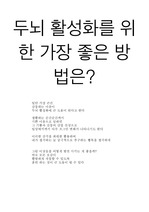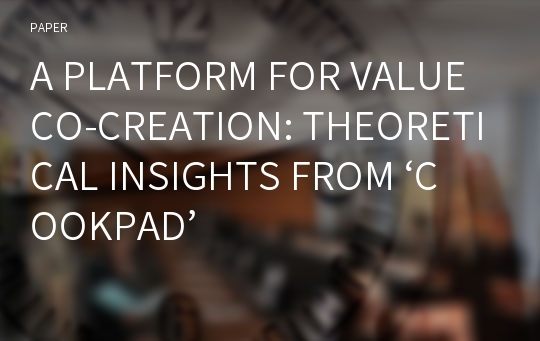A PLATFORM FOR VALUE CO-CREATION: THEORETICAL INSIGHTS FROM ‘COOKPAD’
* 본 문서는 배포용으로 복사 및 편집이 불가합니다.
서지정보
ㆍ발행기관 : 글로벌지식마케팅경영학회(GFMC)
ㆍ수록지정보 : Global Marketing Conference
ㆍ저자명 : Kimihiko Kondo
ㆍ저자명 : Kimihiko Kondo
영어 초록
Introduction Recent research in management and marketing has focused on the concept of value cocreation, and numerous attempts have been made by scholars to clarify the essence and process of value cocreation according to the service-dominant logic (Vargo & Lusch 2006). The value cocreation perspective is substantially different from the traditional value creation perspective in the following two respects. First, while in the value creation perspective the seller or firm is the initiator of value creation and value proposition, the value cocreation perspective considers both the buyer or consumer and the seller or firm to be value-creating actors (Vargo & Lusch 2006). Second, the value cocreation perspective focuses on the fact that value is cocreated through interaction between the seller and buyer, or company and consumer (Vargo & Lusch 2006). The purpose of this paper is to (1) analyze the case of ‘COOKPAD’, the top recipe site in Japan, as a platform for value cocreation, (2) consider the relationship between firms and consumers in the value cocreation process, and (3) draw some theoretical insights on value cocreation, open innovation, and service innovation. While tremendous progress has been made in these research fields, little is known about the ‘platform’ of value cocreation. This paper will focus specifically on the function of ‘platform’ in value cocreation. Case analysis of COOKPAD COOKPAD has following three theoretical features. First, COOKPAD is a service provider, which is thought to be more likely to cocreate value with consumers than goods manufacturing companies (Grönroos 2011). Second, it is an online service provider that operates in an environment where a higher number of consumers are likely to become involved in the value cocreation process. And thirdly, it is a leading-edge case that could provide new theoretical knowledge to the existing theories on value cocreation, open innovation, and service innovation. Overview COOKPAD Inc. was founded in 1997 by an entrepreneur Akimitsu Sano, and the Internet site called ‘COOKPAD’ became the most popular recipe site in Japan in a very short period. In accordance with the corporate mission of ‘making everyday cooking fun,’ it allows users to upload and search through original, user-created recipes. In July 2013, COOKPAD had more than 1.5 million registered recipes, a total of 20 million users, and over 1 million paid subscription users. Currently, it is being used by almost 80-90% of all Japanese women in their 20-30s (COOKPAD 2014). Combined with its mobile and smartphone services which can be used on the go and in stores, COOKPAD plays an influential role in the shopping decisions that consumers make in their everyday lives. Business Model COOKPAD has two revenue-generating businesses. One is a ‘premium service’ business aimed at consumers, and the second business is advertising aimed at food manufacturers (Uesaka 2009). COOKPAD users can search through a large database of recipes using search options such as ingredients, menu, and keywords. Free users can view the recipes, but for them the functionality of the service is more limited. ‘Premium service’ members (a paid service costing ¥294 per month) have access to value-added services such as ‘MY kitchen’ and ‘MY folder’. ‘MY kitchen’ allows a member to upload a recipe with a self-made photo of the food, check the traffic to the recipe, and browse the feedback to the recipe from other paying members. Paying members can also save their favorite recipes in ‘MY folder’, can register their favorite recipe-posting members, and search for new recipes posted by these members. The company’s advertising business offers corporate clients the option to display clickable ads and also runs recipe contests. Its advertising clients include food and beverage manufacturers, and the service aims at enhancing the awareness of client products and services and at enhancing consumer knowledge on how to use these products. More specifically, COOKPAD provides food companies with a virtual space or ‘platform’ to hold recipe contests and to promote their products by inviting users to create recipes for these products. COOKPAD’s cocreated value The value cocreation process of COOKPAD has two aspects. The first is in the relationship with consumers. Consumers upload their vaunted recipes to COOKPAD, and derive great satisfaction from providing other consumers with value by having these other consumers browse and use these recipes. A series of customer experiences (searching for recipes, cooking, uploading recipe) on COOKPAD results in customer satisfaction. The important point here is that consumers are actors who cocreate value in a multilateral and interactional fashion through browsing and uploading of each other’s recipes, while usual cookbooks produced by professionals create value in a unilateral fashion. Therefore, COOKPAD is an interactive platform that promotes value cocreation among consumers. The second aspect is in the relationship with food manufacturers. Usually, food manufacturers try to take in customers’ needs through group interviews and/or consumer surveys to develop more appealing products or services. However, although customer needs may be incorporated in the product development process, it is arguably the food manufacturer that creates value in the form of food products. Also, it is usually the manufacturers who propose recipes using their ingredients to consumers on their websites, and, in this case, they use the website as a one-way communication channel for their products. In contrast, COOKPAD plays not only the role of a platform where food manufacturers place Internet advertisements, but they can also ask consumers for ideas on how to use the ingredients in the form of ‘recipe contests’. In the case of COOKPAD the value-creating actors are not the food manufacturers that strategically promote the usage of their ingredients, but instead it is the consumers —usually considered value receivers in the goods-dominant logic— who perform this role. The value cocreation on COOKPAD is based on the fact that it is a platform connecting two markets. Platform is defined as the tool and/or system that functions as a communication infrastructure promoting cooperation among multiple types of actors (Kokuryo & Platform Design Lab 2011). Applying this definition to COOKPAD, the multiple types of actors are the many consumers and food manufacturers using the COOKPAD website, the interactive cocreation among these actors embodies the cooperation aspect, and the COOKPAD website is the platform that provides the communication infrastructure that enables the cocreation process. COOKPAD in fact consists of two platforms: a platform of consumers and a platform of food manufacturers. This type of platform has been called a two-sided platform where products and services are brought together by groups of users in two-sided networks (Eisenmann, Parker, & Van Alstyne 2006). In a two-sided platform two unique effects appear, namely same-side network effects and cross-sided network effects. Same-side network effects “are created when drawing users to one side helps attract even more users to that side” (Eisenmann, Parker, & Van Alstyne 2006, p.96). On COOKPAD’s platform, a large number of consumers upload various recipes, and more consumers who are attracted to the variety of recipes start to use them. The cross-side network effects are generated “if the platform provider can attract enough subsidy-side users, money-side users will pay handsomely to reach them” (Eisenmann, Parker, & Van Alstyne 2006, p.96). Indeed, in the case of COOKPAD, the large number of subsidy-side consumers attracts money-side food manufacturers to the platform who are willing to pay the advertisement rates to reach those consumers. Theoretical insights from the case Based on the COOKPAD business model, we would like to propose some theoretical insights to existing research in value cocreation, open innovation, and service innovation. First, the situation in which consumers actively engage in value cocreation and generate product innovation has been understood as ‘user innovation’. The users engaging in innovation are called ‘lead users’. Lead users are defined as those who have advanced knowledge related to a specific field, participate in product development and the service provision process, and cocreate value with firms (von Hippel 1988). This means that in this case the value cocreation is limited to lead users who are able to generate user innovation. The important point here is that users who cocreate value on COOKPAD are not lead users with advanced cooking knowledge, but amateurs in cooking, which is different from the premise of user innovation theory. COOKPAD functions as a platform that accumulates numerous knowledge resources on cooking by connecting these ordinary consumers and food manufacturers. Therefore, COOKPAD can be positioned as a value cocreation platform integrating consumers’ resources. Secondly, this feature of COOKPAD provides an important implication for research on open innovation. Open innovation is defined as the use of purposive inflows and outflows of knowledge to accelerate internal innovation, and to expand the markets for external use of innovation, respectively (Chesbrough 2006). The value cocreation platform of COOKPAD is the very infrastructure that invokes open innovation. And this aspect represents a strategy that is completely opposite to the strategy of developing a solid customer base by enclosing good customers and gaining higher profit, as typified by CRM (costumer relationship management). COOKPAD develops a relationship for cocreating values with a large indefinite number of consumers and reaps profit from paying members who are highly loyal to it. And thirdly, in association with the value creation network, the network has been considered in the concepts of value constellation (Norman & Ramírez 1993) and value network (Lusch, Vargo, & Tanniru 2010), and both of these concepts focus on the network of value-creating actors and the relationship in which the actors create one value. However, the COOKPAD platform goes beyond these concepts in the sense that recipes as cocreated values are generated emergently through consumers’ positive commitment to value cocreation. COOKPAD invoking open innovation includes a possibility of emergent value cocreation. Emergence is defined as a phenomenon in which unpredictable value added can be generated through interaction among multiple actors (Kokukyo & Platform Design Lab 2011, p.260). Both COOKPAD and consumers are not able to predict in advance what kind of value-added recipes will be uploaded, and food manufacturers cannot foresee what kind of recipes will be submitted in recipe contests. Recipes as cocreated value cannot be determined in advance, and thereby, COOKPAD is also a platform with a post-emergent process, which means a process in which the value that customers experience is not determined in advance by both firms and consumers, and the real value only becomes apparent for the first time during the use process (Ono et al. 2014). Conclusion As we analyzed above, COOKPAD has unique features in three ways. Firstly, it is a platform in which all values are generated by a cocreation process between consumers and firms. Secondly, the innovation on COOKPAD has a character of open innovation by numerous amateur consumers. Thirdly, the innovation cannot be fully determined in advance by COOKPAD, food manufacturers, and consumers. We believe we will be able to contribute to research on value cocreation, open innovation, and service innovation by further exploring the case of COOKPAD.참고 자료
없음"Global Marketing Conference"의 다른 논문
 THE ROLES OF GREEN PACKAGING IN UGLY FOOD PURCHASE INTE..22페이지
THE ROLES OF GREEN PACKAGING IN UGLY FOOD PURCHASE INTE..22페이지 THE IMPACT OF INDUCED AWE ON ETHICAL TOURIST BEHAVIORS5페이지
THE IMPACT OF INDUCED AWE ON ETHICAL TOURIST BEHAVIORS5페이지 A BIBLIOMETRIC ANALYSIS OF SPIRITUAL TOURISM RESEARCH15페이지
A BIBLIOMETRIC ANALYSIS OF SPIRITUAL TOURISM RESEARCH15페이지 SOCIAL NETWORK ANALYSIS AND RESPONSE TIME TESTING: CONS..11페이지
SOCIAL NETWORK ANALYSIS AND RESPONSE TIME TESTING: CONS..11페이지 THE EFFECTS OF PARA-SOCIAL INTERACTION ON ONLINE CELEBR..3페이지
THE EFFECTS OF PARA-SOCIAL INTERACTION ON ONLINE CELEBR..3페이지 THE INFLUENCE OF OPINION LEADERS ON DAILY DEALS USER’S ..3페이지
THE INFLUENCE OF OPINION LEADERS ON DAILY DEALS USER’S ..3페이지 HOW IMMERSIVE RETAILING AFFECTS CONSUMERS’ URGE TO BUY:..6페이지
HOW IMMERSIVE RETAILING AFFECTS CONSUMERS’ URGE TO BUY:..6페이지 KEY TO SUPERSTARDOM IN A GLOBALISED MARKET: THE ROLE OF..6페이지
KEY TO SUPERSTARDOM IN A GLOBALISED MARKET: THE ROLE OF..6페이지 A POST-PANDEMIC LOOK AT TOURISTS’ PERCEIVED COOLNESS OF..4페이지
A POST-PANDEMIC LOOK AT TOURISTS’ PERCEIVED COOLNESS OF..4페이지 EXTRACTING OFFLINE RETAIL SHOPPING PATTERNS: OLLABORATI..5페이지
EXTRACTING OFFLINE RETAIL SHOPPING PATTERNS: OLLABORATI..5페이지




















